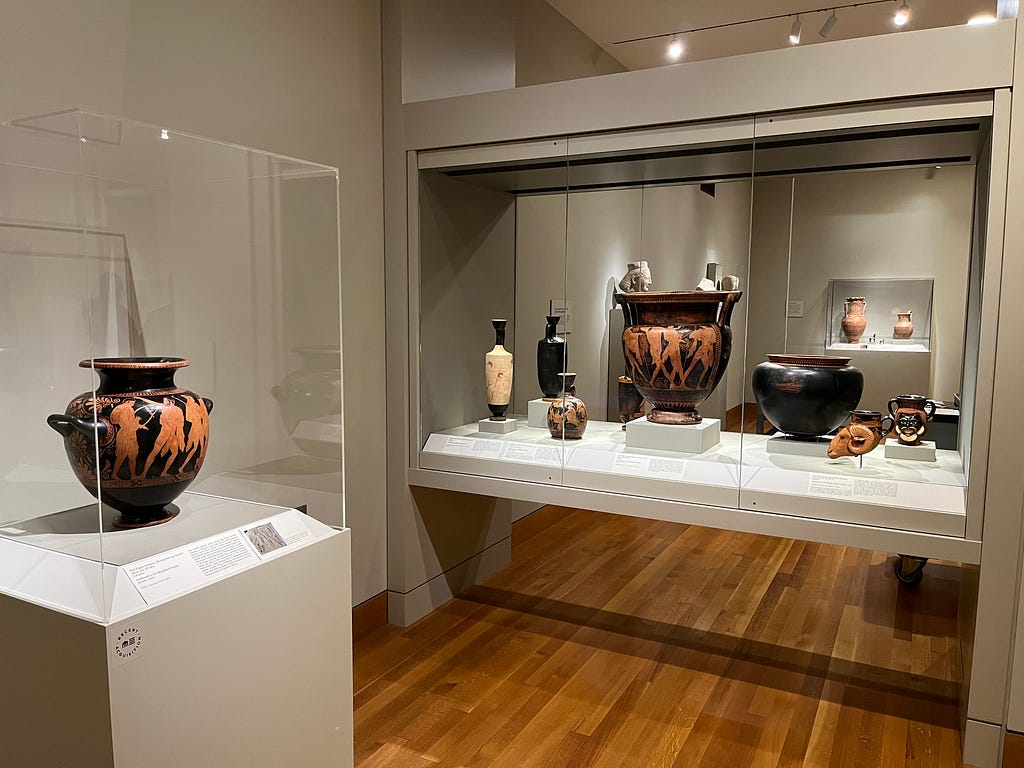By Seth Pevnick, Curator of Greek and Roman Art
Each of the lots of ancient Greek vases on view in the Dr. John and Helen Collis Family Gallery (102B– C) has numerous stories to inform (fig. 1). Their painted figures, whether black or red, human or animal, might reveal characters from ancient folklore or actions of or occasions from life. Their shapes and decor can offer ideas to useful functions, and the potters and painters who made them might be understood– periodically by name from signatures, however more frequently called by scholars based upon mindful research study and links to comparable vases in other collections. The names of owners of Greek vases can in some cases be figured out, too– sometimes ancient owners, if we can rely on engravings scratched into their surface areas, however more often contemporary owners, if great records exist.

While lots of vases have actually remained in the collection for years and their stories informed various times, we focus here on a brand-new arrival, gotten in March and put on view in May. This commanding vase is a reasonably uncommon shape called a stamnos, a high-shouldered, wide-mouthed vessel with 2 horizontal deals with at the largest point (fig. 2a– c). Made in or around Athens, seemingly for blending and serving white wine at Greek seminar (drinking celebrations), Attic red-figure stamnoi appear to have actually been more popular in ancient Italy than in Greece. They were most likely made mainly for the export market, often ending up being cinerary urns in Etruscan burial places. Unlike kraters, consuming cups, or amphorae, more typical shapes with numerous countless extant examples, less than 500 red-figure stamnoi endure in modern-day collections worldwide.Whether for Greek or
Etruscan taste, red-figure stamnoi often include wine-related iconography, consisting of the komos, a post-symposion revel sustained by white wine and music. Here, a carefully dressed lady plays the pipelines at right, leading 3 almost naked male figures throughout the vase (fig. 2a ). Simply behind her, a boy brings a strolling stick and reaches forward, while his bearded buddy holds a drinking cup and extends one restore, obviously dancing and feeling the impacts of his white wine. A more made up boy follows, focusing on the music of his lyre. All 4 figures stride barefoot throughout a meander band stressed with squares. Figure 2a– c. Red-Figure Stamnos(Mixing/Storage Vessel): Komos(Musicians and Revelers), c. 435– 425 BCE. Credited to the Kleophon Painter(Greek, Attic, active c. 440– 410 BCE). Ceramic; h. 40.4 cm; diam. of foot 13.8 cm; diam. of mouth 23.5 cm; w. with deals with 39 cm. The Cleveland Museum of Art, John L. Severance Fund, 2023.3( BAPD 215150 )With small variations, this band surrounds the vase, linking the front, the back, and the 2 side panels, which the painter has animated with extreme palmettes and tendrils surrounding the manages (fig. 2b). 3 draped boys inhabit the reverse, the one at best gesturing back towards the other 2(fig. 2c). Above his outstretched arm is a little white wine container, linking to the livelier komos of the other side.Similar komos scenes appear on a number of other stamnoi credited to the Kleophon Painter. One in the State Hermitage Museum (Saint Petersburg, Russia; BAPD 215147 )bears the engraving Kleophon kalos(” Kleophon is gorgeous “), providing a name to the otherwise confidential painter.Part of a bigger group referred to as the Polygnotans(after its leader, Polygnotos ), the Kleophon Painter was among the most essential vase-painters operating in Periklean Athens, when the terrific structures of the Athenian Acropolis were being constructed. Especially, their vases frequently reveal the impact of the sculptural design of the Parthenon, the popular temple of Athena constructed in between 447 and 432 BCE. This is most evident in the solemn sacrificial procession on an exceptional volute-krater now in the Museo Archeologico Nazionale di Ferrara (BAPD 215141 ). The painter developed much more dynamic figures as well, in the lower frieze of the volute-krater and on the stamnoi now in Cleveland, Saint Petersburg, and in other places. Regardless of the really various topic, numerous of the artists and revelers on the Cleveland stamnos can be positively compared to figures from the north frieze of the Parthenon, finished under the instructions of the carver Pheidias. The bearded reveler on the stamnos, for instance, strikes a position rather like that of an almost naked parade marshal gesturing drastically behind a chariot on a frieze block in the Acropolis Museum in Athens (fig. 3). Figure 3. Area of the north frieze of the Parthenon(Block 23 [XXIII] ).

scenes appear on numerous other CMA vases, all date previously and none has the beauty of this stamnos, its fragile figures so well balanced with its shape. In many methods– date, shape, painter, iconography– the stamnos has actually included to the CMA collection, transferring visitors throughout time and area to the world of Classical Athens.But the vase can inform other stories, too, as an appearance below its foot recommends( fig. 4 ). The majority of the marks seen here appear to match the taped contemporary history of the vase(noted under” Provenance”in Collection Online, with matching publications in”Citations “). Figure 4. Underside of the CMA’s Red-Figure Stamnos The biggest mark, in thick

Each of the lots of ancient Greek vases on view in the Dr. John and Helen Collis Family Gallery (102B– C) has numerous stories to inform (fig. 1). Before this vase was obtained, the CMA collection did not consist of a single stamnos nor any vases by the Kleophon Painter. Komos
scenes appear on a number of other CMA vases, all date previously and none has the beauty of this stamnos, its fragile figures so well balanced with its shape. The biggest mark, in thick
